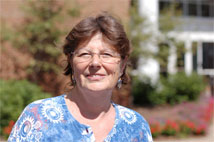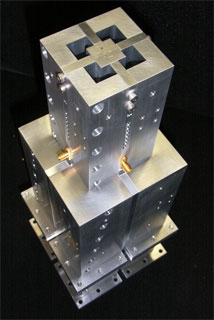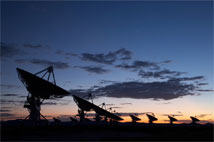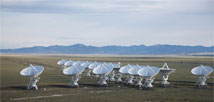NRAO eNews
September 2008 • Vol. 1, Iss. 4
- Water, Water, Everywhere?
- ALMA Construction
- Carol Lonsdale Joins NRAO to Lead the North American ALMA Science Center
- Expanded Very Large Array Status
- The EVLA Vision: Galaxies through Cosmic Time
- Career Opportunities
- Call for Proposals for NRAO Telescopes
- Approved Joint Chandra/NRAO Proposals for Cycle 10
- Approved Joint Fermi/NRAO Proposals for Cycle 1
- GUPPI Ready for Expert Users
- GBT K-band Focal Plane Array
- Observing with the VLA-EVLA Transition Array
- VLBA Sensitivity Upgrade
- VLBA Recording Media
- NRAO Lab Notebook
- The 2008 NRAO Summer Student Program
- Governor is Inspired by Governor's School Students
- West Virginia Pulsar Search Collaboratory Underway
- Archive
- Contact the Editor
- Subscribe
- More Information
NRAO eNews: September 2008 • Volume 1, Issue 4

The students and teachers of the 2008 West Virginia Governor's School for Math and Science at the Green Bank Telescope.
Water, Water, Everywhere?
Jeremy Darling (University of Colorado), Crystal Brogan (NRAO), and Kelsey Johnson (University of Virginia/NRAO)

Figure 1: Three-color archival Spitzer images of (a) He 2-10, (b) the Antennae, (c) NGC 4214, and (d) NGC 5253 with RGB mapped to 24, 8, and 3.6 µm. In these images red colors pinpoint the most active regions of star formation. The locations of the 33'' GBT beam are indicated with green circles; the positions of the two Antennae nuclei are also indicated. The GBT beam corresponds to a physical scale in these galaxies of 1.7, 3.2, 0.47, and 0.53 kpc, respectively.
The cocoons of dusty, dark, molecule-rich gas clouds found in our own Milky Way galaxy and beyond are nurseries for new stars. Star formation in the Milky Way is slow and steady, but in other galaxies great bursts of star formation can and do occur. These events generate large populations of stars at once, consuming or dissipating much of the gas in the process. Such starburst galaxies range in type and size from small dwarf starbursts to massive colliding galaxies. Starbursts are an important part of galaxy evolution and star formation in the universe and were the dominant means of new star formation when the universe was half its current age.
Bright water masers are a common signature of stellar nurseries in our own galaxy. In fact, most regions containing young stars in the Milky Way show signs of water. A water maser is a laser-like beam of microwaves that naturally forms when water molecules are excited by shockwaves or strong infrared (thermal) radiation. Water masers occur naturally and at the same frequency used by microwave ovens.
In a recent survey, we discovered water in every starburst galaxy we observed and anticipate water to be a ubiquitous signature of star formation. Pointing the giant Green Bank Telescope (GBT) deep into space, we detected water masers in three dwarf starburst galaxies and the famous Antennae Galaxy. The Antennae is a dramatic collision of two massive spiral galaxies, resulting in tremendous bouts of star formation.
These discoveries were only possible with the exquisite sensitivity of the GBT. Some of the masers are as much as 100 times less luminous than Milky Way water masers, suggesting that water masers should be observable in nearly all nearby star-forming galaxies. The masers we observed are not exceptional cases; instead they are commonplace.
Stellar nurseries are very dusty places that visible light cannot penetrate — they are hidden from our view. However, radio waves can pass through the dusty veils surrounding new stars to reveal a clear view. Radio telescopes also provide extremely sharp pictures of these regions because we can form Earth-sized telescopes with radio dishes strung across the globe. These images can be so sharp that it is possible to track the motions and gyrations of galaxies over years of steady observations.
The main utility is a high brightness temperature probe of extragalactic star-forming regions that can be observed with interferometers including VLBI. We can also identify sites of highly obscured star formation and possibly do proper motion measurements of very nearby systems. This also tells us that water is present where stars form — not surprising, but not directly confirmed in very many extragalactic cases.
This discovery opens a new field of research and a new high-resolution window on star formation in other galaxies. We have known for some time that water is present at most sites of star formation in our Galaxy, but we now know that it is often and perhaps always present in the stellar nurseries of other galaxies as well.
Our results are reported in the September 20 issue of Astrophysical Journal Letters, and are also available at http://arxiv.org/abs/0808.2643.
ALMA Construction
Al Wootten
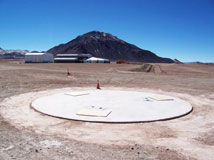
Figure 1. Antenna station A93. The AOS Technical Building is between A93 and Chajnantor, and the Transporter Hangar is at left. (Photo S. Cabezon)
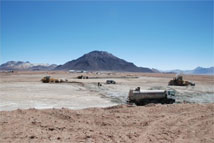
Figure 2. Grading proceeds at the center of the array. Antenna station A93, the Technical Building, and the Hangar are in the distant background against Chajnantor.
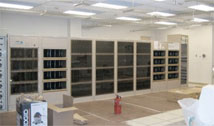
Figure 3. The first quadrant of the bilateral correlator that will eventually link 64 antennas has been installed in the AOS Technical Building.
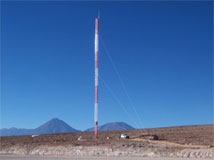
Figure 4. A new holography system, built at the NRAO Technology Center, will be assembled at the OSF Technical Building. The transmitter will be mounted atop the recently finished holography tower. The Licancabur volcano (left) and Juriques (right) are in the background.
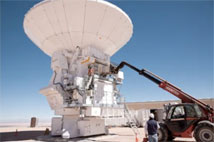
Figure 5. Instrumentation racks for the ALMA Back End were loaded into a Mitsubishi 12m antenna recently. The first receiver complement (Front End) will join them shortly.
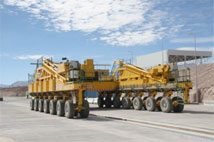
Figure 6. The ALMA transporter prowls the antenna integration area in the OSF Technical Building compound. The Transporter Shelter is in the right background. (Photo A. Beelen).
Array Operations Site
Construction of the network of antenna pads, as well as the roads, electrical cables and network cables tying them all to the Technical Building, has proceeded at the 16,400 foot elevation Array Operations Site (AOS). As each antenna pad receives its structural concrete, a curing process must follow, with the structure protected by a tent. To date, seventeen pads at the high site have received their concrete. The closest of these to the main building is A93, to which the first accepted antennas may move for high altitude testing and the later stages in the process of Assembly, Integration and Verification. This antenna station lies in the foreground in Figure 1, with the Technical Building and the Transporter Hangar visible in the background, to the North.
About a third of the work to build the 200+ antenna foundations that comprise ALMA will be concentrated in the region of the central cluster. Grading of this area is underway, as the short baselines needed for Commissioning and Science Verification are available in this portion of the array.
With the pads now under construction, the network of roads, electrical connections and fiber that tie them to the Technical Building are also being built. The 16-station NAOJ correlator, installed there last December, has now been joined by the first quadrant of the bilateral correlator (Figure 3), which can serve 32 antenna stations. All first quadrant correlator racks have been installed, and they have been partially populated with boards. The process of inter-rack cabling has begun. A quick test of a station bin and a correlator bin showed a good cross-correlation spectrum.
Operations Support Facility
Holography of production antennas has been occurring from the vendor areas at the Operation Support Facility (OSF) using a holography transmitter mounted on a tower near the temporary offices.
With the arrival of the seventh Vertex antenna at the end of August, the total number of production antennas at the OSF reached eleven. Outfitting of the second NAOJ antenna has begun, with the emplacement of the instrumentation racks for the Back End. These racks are assembled at the Pete Domenici Science Operations Center in Socorro. Testing of the second set at the OSF has also occurred.
The first ALMA Front End, containing the receiver cartridges, should be mounted on this antenna soon. Over the next several weeks, the ALMA Project expects to take possession of the first production antennas as acceptance testing finishes. At that point, the antennas will be moved by the ALMA transporter to a large courtyard within the Technical Facility area and holography will continue using a transmitter mounted on a nearby, recently-built tower. Further integration of ALMA equipment into the antenna will occur at the OSF.
As activity accelerates in Chile, the period of integration and testing at the ALMA Test Facility winds down. That facility will continue to operate at a reduced level through the end of the year. Interferometry there is now routine and a modest flux monitoring activity continues, though most of the effort focuses on getting the total power testing routines needed to test the production antennas in Chile operating efficiently.
Carol Lonsdale Joins NRAO to Lead the North American ALMA Science Center
John Stoke
We are pleased to announce the appointment of Carol Jean Lonsdale as the new NRAO Assistant Director for the North American ALMA Science Center (NAASC). As NAASC head, Carol will lead the team that will enable North American astronomers to effectively use the new observatory, support ALMA operations in Chile, and undertake research and development for future ALMA upgrades.
Dr. Lonsdale, who earned her Ph.D. at the University of Edinburgh, brings to NRAO a rich legacy of experience in overseeing large astronomical projects and the people who make them possible. She gained much of that experience in senior positions at Caltech’s Infrared Processing and Analysis Center (IPAC), where she has served as Senior Research Scientist, Head of Science Staff, Acting Director, and Manager of the Wide-Field Infrared Explorer and the Infrared Science Archive. Carol has participated as science team member on IRAS, 2MASS, WISE, and WIRE, and studies galaxy formation and evolution.
Several weeks before her formal 1 October start date, Carol sat down with us for a short chat about her upcoming work …
Carol, soon you will head an organization whose success will depend upon helping optical astronomers cross the bridge between visible and millimeter/sub-millimeter light. You’ve worked extensively ON that “bridge,” as it were, in infrared astronomy. Has your infrared experience helped prepare you for the challenges of making ALMA accessible to astronomers who may not have previous experience in the millimeter realm?
I certainly expect that to be the case. I’ve had a long experience at the Infrared Processing and Analysis Center, which was developed to support the IRAS mission back in the mid-1980s. Over the years we added several other infrared programs and a lot of people came in to use the data, everyone from X-ray to radio astronomers. Infrared is pretty mainstream now, especially with Spitzer up there. A lot of people have learned to use Spitzer very effectively for their multi-wavelength work. Millimeter is now in its infancy, and it’s about to explode. The community is going to see the enormous advantages of including millimeter wavelengths in their studies of whatever it is they’re looking at, and I’m sure we can benefit from the model of how people learned to use the infrared.
Your research interests include galaxy formation, active galactic nuclei, luminous infrared galaxies, and the cosmic infrared background. What does ALMA hold in store for you, and for scientists with similar interests? What are some of the big questions in these areas that ALMA will help us answer?
Well, ALMA is going to be a key for this work, because we’ve discovered over the past couple of decades that there’s as much radiation emerging in the infrared/millimeter/sub-millimeter part of the spectrum as there is in the shorter wavelengths. We’ve done this by comparing the energy in the cosmic backgrounds. So half the energy in the universe has been hidden from us until we could look at longer wavelengths. Even looking in the infrared – which has been a huge step forward – we’re still way on the short end of the spectrum of dust emission from the galaxies that are responsible for all of this light. It takes much longer wavelengths to actually detect that radiation. With ALMA we’ll be able to determine the luminosities, and therefore the star-formation rates, of galaxies as they’re being formed. We’ll have the opportunity to map the energy both spatially and spectrally, which will just be a fascinating step forward.
How do you see ALMA complementing current and future infrared observatories, such as JWST?
ALMA and JWST have got very similar power but at very different wavelengths. JWST will be following up objects that are discovered in the very large surveys in the near-infrared, and then ALMA will look at them in the millimeter and we’ll get complementary information. JWST will tell us a lot about the mass in the older and/or evolved stars and ALMA will tell us about the new star formation regions and about the active nuclei.
The concept of a facility “science center” is new for NRAO. What are the most important benefits that the North American ALMA Science Center will bring to the astronomical community?
Well, the goal is that NAASC will make ALMA science accessible to the non-expert. Interferometry is at present a specialized science, with a small community of experts. In the past if you needed some information for your source in the radio or the millimeter, you tended to acquire a collaborator who would do the interferometry. The enormous potential of ALMA will change all that, bringing many more people directly into contact with the data. We’re in an epoch now where that can be accomplished by building a science center like the NAASC, opening up ALMA to a much wider range of science users.
Your undergraduate degree, as well as your Ph.D., is in astronomy, which suggests that you caught the bug relatively early in life? What, or who, inspired your interest in the universe and in an astronomy career?
Funny as it is, the person who inspired me to do astronomy was my younger brother! He’s two years younger than me and currently he’s director of Haystack Observatory. His name is Colin Lonsdale. When he was a kid he knew he wanted to be an astronomer. When he was seven years old he was building telescopes. And for a while I was the big sister who naturally tended to want to do the opposite of my little brother! But the skies captivated me too in the end, when it came time to pick something to study at college. I had to admit, then, that Colin was on to something!
You have been a manager of people, tasks, and large projects. How did you learn to do that?
I learned it on the job! JPL is a large organization, and IPAC, though it transferred to Caltech early on, originated at JPL. So I took some management classes that JPL organized. We started out as a small organization and when the head of the science group got promoted to the head of IPAC, there was an opening for the head of the science group and I was appointed to that and learned how to manage on the job. One of the most important things I’ve learned is the need to facilitate effective communication between people. You can have someone sitting in a room trying to solve a problem that someone else in another team has solved already, so a big part of effective management, in our science, is being aware of who is doing what and coordinating those things.
When you were entering the field (two years ahead of your brother!), studying in Scotland and afterwards moving to the United States, were many of your colleagues women?
No, not many at all in those days. In the early days, when I was training, frequently I’d be the only woman in a meeting, and that could be an interesting experience! Things have changed a lot; we’ve got a lot of women now in positions of leadership and management, along with a lot of women scientists doing excellent science. It’s great to see.
Expanded Very Large Array Status
M. M. McKinnon and the EVLA Project Team
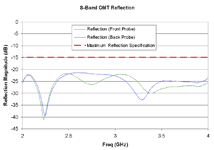
Figure 2. Test results from the EVLA S-band OMT showing reflection performance exceeding specification by over 5dB across the entire receiver band.
Significant progress on the WIDAR correlator has been one of the most exciting developments for the EVLA project over the summer of 2008. All 16 equipment racks for the correlator have been installed. The correlator boards that will be installed in the racks are connected to one another by a total of 500 high speed data cables, each capable of supporting data rates of about 10 Gbps. The high speed data cables, correlator network cables, and 48V power cables were installed. The test rack, two station boards, and baseline board for a separate, prototype correlator (PTC) were also installed over the summer. After a great deal of trouble-shooting and systems integration effort, a “first fringes” observation on a single baseline was made with the PTC on August 7, 2008. The observation is described in a recent NRAO press release.
Exciting results are being obtained with the EVLA’s new wideband orthomode transducers (OMTs). The first two, full bandwidth, C-band (4-8 GHz) OMTs were installed on the array over the summer. Astronomical test observations show that the amplitude of the cross-polarization “leakage” terms of the EVLA C-band receivers are approximately 4% across the entire 4 GHz of receiver bandwidth, in comparison to the 8% leakage terms that are typically measured across 50 MHz of bandwidth on a VLA receiver. The second, and final, version of the S-band (2-4 GHz) OMT was fabricated and tested (Figure 1). Tests of the OMT show that it exceeds design specifications (Figure 2). The design of this OMT implemented the design philosophy and lessons learned from improvements to the C-band OMT.
The prototype Ka-band (26-40 GHz) receiver was shown to meet project specifications. Two Ka-band receivers have been installed on the array, and first fringes with them were recorded by the VLA correlator on August 8, 2008. Three more receivers are being assembled in the laboratory for installation on the array over the next few months.
The production of receiver feed horns continues ahead of schedule. The assembly and fiberglass lamination of all L-band (1-2 GHz) feed horns are complete. The assembly and fiberglass lamination of the S-band horns are well underway. The second S-band horn was installed on antenna 3 after antenna pattern measurements on June 9 showed that it complied with design specifications. The lamination of the third S-band horn is nearing completion. Antenna pattern measurements were made of the two, prototype Ku-band (12-18 GHz) feed horns on June 10-13 at an antenna test range on the New Mexico Tech campus. The measurements show that the horns meet design specifications.
Antennas continue to be retrofitted to the EVLA design at the rate of six antennas per year. A total of 17 antennas are now used in scientific observations and accounted for 57.8% of all antenna hours used in observations in July 2008. The mechanical overhaul of the 18th antenna is nearly complete.
Engineering samples of the 3-bit, 4 Gsps digitizer were delivered to the electronics laboratory in Socorro. Tests of these digitizers show that they perform as expected in the EVLA wideband sampler module. Additional, digitizer-specific tests are currently being made by the vendor at a testing laboratory at Wright-Patterson Air Force Base in Dayton, OH. All digitizer chips should be delivered from the vendor by October 2008. The assembly and installation of the digitizer modules will proceed slightly in advance of the printed circuit boards for the WIDAR correlator.
A preliminary version of the Science Data Model (SDM) has been incorporated into the data capture and format (DCAF) module of the EVLA monitor and control system. DCAF is the module that captures science metadata as observing scripts are executed, then reformats and stores it in a set of tables that is the SDM. These data are then written to a staging area where they are ingested into the next generation archiving system (NGAS) together with binary data from the correlator. At the present time, this is a preliminary system intended for use in on-the-sky testing of the PTC. However, it is now routinely being run on metadata from VLA observations. The version of the SDM being used is the same version currently being used at the ALMA Test Facility (ATF). A compatible version of the Binary Data Format (BDF) is also supported and has been tested with simulated data from the correlator subsystem. This combination of the SDM metadata and binary data has been successfully loaded into CASA using the same software filler that is being used at the ATF. A new NGAS server was installed at the VLA to support on-the-sky testing of the PTC. This is a smaller archive system that is intended as a staging area for science datasets.
The effort of the EVLA Science Support Systems group has been devoted to the web-based Observation Preparation Tool (OPT). The OPT needs to be able to support observatory staff in the configuration and testing of a ten-station prototype WIDAR correlator later this year and will be used to support Ka-band observing with the current VLA correlator. The OPT consists of three main components: one for configuring instrumentation, one for maintaining catalogs of target sources and calibrators, and one for assembling actual observing programs. The instrument configuration component is ready for use with EVLA antennas and the VLA correlator. The source catalog component is also ready for use, although a number of additional features will be added to it in the near future. More testing is required on the observation setup component before it can be deemed ready for use.
The AUI Visiting Committee met on April 8-9, 2008. The committee was impressed with the steady progress of bringing the EVLA to completion and noted that nearly all of its recommendations from a previous report had been addressed.
The EVLA Vision: Galaxies through Cosmic Time
Jacqueline van Gorkum (Columbia), Andrew Baker (Rutgers), Amy Barger (Wisconsin), Stefi Baum (RIT), Chris Carilli (NRAO), Sean Dougherty (NRC-HIA), and Rob Ivison (ROE/ATC)
The EVLA will have a continuum sensitivity 10 times the VLA, frequency coverage between 1 and 50 GHz that can be observed with an instantaneous bandwidth of up to 8 GHz, and at least 16 000 channels in each polarization. This vast increase in observing power brings unprecedented scientific capability to centimeter wavelengths that emplaces the EVLA as a world-leading radio telescope in the next decade.
With limited shared-risk observing starting in approximately late 2009, and full operational capability in 2012, the NRAO is sponsoring and hosting the first of a series of workshops to bring together astronomers from across the electromagnetic spectrum to start exploring the wide-range of science questions where the EVLA will be a pivotal instrument.
The first workshop of this series will focus on galaxy evolution through cosmic time. Recent years have seen a wealth of data on galaxy properties from low to very high (z > 7) redshift, greatly improving our insights on galaxy evolution, but raising many new questions. In particular, the large surveys (both wide and ultra deep) have contributed to a better understanding of the global picture. One of the great strengths of the EVLA will be its survey capability, both in continuum and spectral line.
Topics to be discussed include: (1) gas and galaxy evolution, (2) the evolution of structural properties of galaxies, and (3) cosmological surveys, wide and ultra deep. Included will be a general deliberation regarding surveys using the EVLA.
The workshop will highlight the new capabilities of the EVLA and the anticipated timeline of the availability of increasing capability. A number of talks will discuss challenging projects that highlight the capability and flexibility of the instrument.
Most workshop presentations will be contributed talks of 15 to 25 minutes, and we encourage speakers to consider how the EVLA might contribute to their field. There will be a number of break-out sessions for smaller group discussion of projects that could be carried out as shared-risk early science project and that would advance the science areas discussed in the plenary sessions.
The 3-day workshop will be held in Socorro, NM on December 16 - 18, 2008 (Tuesday - Thursday). Registration will open on September 22, 2008 at http://www.aoc.nrao.edu/events/galform. There will be no proceedings, but contributions (PowerPoint or PDF) will be posted and archived on the web.
Career Opportunities
NAASC Scientist - CASA Scientific Software Developer: The North American ALMA Science Center (the NAASC) has an opening for a scientist to work on the development of the new ALMA data reduction and analysis package CASA (Common Astronomy Software Applications).
NAASC Scientist - Commissioning Liaison: The North American ALMA Science Center (the NAASC) has an opening for a scientist to work, during commissioning and verification, as a liaison between the NAASC, which is headquartered at the NRAO headquarters in Charlottesville, VA and the ALMA telescope at its high site in northern Chile.
Tenure Track Astronomer: The National Radio Astronomy Observatory (NRAO) has an opening for a tenure track astronomer position. The highest priority of the Observatory is to recruit new scientific staff that will enhance the scientific use and development of our new flagship facilities ALMA and EVLA.
NAASC Postdoctoral Fellow - Splatalogue: The North American ALMA Science Center (NAASC) located at NRAO headquarters in Charlottesville, VA (on the campus of the University of Virginia) invites applications for a postdoctoral fellow to work with the NAASC scientific staff as it gears up to support the needs of the community when ALMA early science begins in 2011. This position is aimed primarily at independent research, but with an emphasis on exercising ALMA end-to-end software and databases from a scientific perspective.
NAASC Postdoctoral Fellow - CASA: The North American ALMA Science Center (NAASC) located at NRAO headquarters in Charlottesville, VA (on the campus of the University of Virginia) invites applications for a postdoctoral fellow to work with the NAASC scientific staff as it gears up to support the needs of the community when ALMA early science begins in 2011. This position is aimed primarily at independent research, but with an emphasis on exercising ALMA end-user software from a scientific perspective.
ALMA Commissioning Scientists: The Joint ALMA office is seeking commissioning scientists to assist the Project Scientist and Deputy Project Scientist in planning and executing the scientific commissioning of ALMA. The successful applicants will be expected and encouraged to continue an active program of independent research.
2009 Jansky Fellowships: The National Radio Astronomy Observatory (NRAO) announces the 2009 postdoctoral Jansky Fellowship program that provides outstanding opportunities for research in astronomy. The purpose of the program is to provide an opportunity for young scientists to establish themselves as independent researchers so that they may more effectively compete for permanent positions.
Call for Proposals for NRAO Telescopes
J. M. Wrobel and R. C. Bignell
NRAO announces the Call for Proposals for trimester 09A. The call is open now and will close on October 1, 2008 at 17:00 EDT. Details of the call for the Green Bank Telescope (GBT) for observing from February 1, 2009 through May 31, 2009 can be found at http://www.gb.nrao.edu/gbtprops/latestgbtcfp.shtml.
The call for the VLA is for proposals for the BnA configuration (23 January - 9 February 2009), the B configuration (13 February - 18 May 2009), and the associated moves. Details of this call for the VLA and VLBA/HSA as well as the ‘News for VLA/VLBA/HSA Proposers’ can be found at http://www.vla.nrao.edu/astro/guides/news.
Approved Joint Chandra/NRAO Proposals for Cycle 10
J. M. Wrobel

Recognizing that radio observations using the NRAO facilities will be important to the scientific exploration by the Chandra X-ray Observatory, up to 3% of the total observing time on each NRAO telescope was made available for joint observing. Chandra Cycle 10 observing will begin in 2008 December. The following joint Chandra/NRAO proposals were approved for Cycle 10:
- Rachel Osten, University of Maryland, Exploring the Stable Coronae of LP349-25 through X-ray and Radio Emission, 13 VLA hours
- Jon Miller, University of Michigan, High Resolution Spectroscopy of a Black Hole Transient, 4 VLA hours
- Stephane Corbel, Centre d'Etudes de Saclay, X-ray Jets in Microquasars, 4 VLA hours
- Isabelle Grenier, Centre d'Etudes de Saclay, ToO Observations of a New Bright Transient Discovered by GLAST and Swift, 1 VLA hour
- Peter Jonker, Smithsonian Astrophysical Observatory, Following a Black Hole Candidate X-ray Transient to Quiescence, 15 VLA hours
- Jon Miller, University of Michigan, The Disk-Jet Connection in Seyfert-1 AGN, 10 VLA hours
- Diana Worrall, University of Bristol, Mothering and Smothering: AGN in Merging Galaxies, 9 VLA hours
- Lori Lubin, University of California - Davis, Local versus Large Scale: The Active Galaxy Population in High-Redshift Clusters, 40 VLA hours
Approved Joint Fermi/NRAO Proposals for Cycle 1
J. M. Wrobel
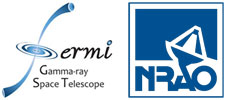
Recognizing that radio observations using the NRAO facilities will be important to the scientific exploration by the Fermi Gamma-ray Space Telescope, up to 10% of the total observing time on each NRAO telescope was made available for joint observing. Fermi Cycle 1 observing began in 2008 August. The following joint Fermi/NRAO proposals were approved for Cycle 1:
- Fiona Harrison, Caltech, GRB Energetics in the GLAST Era, 135 VLA hours
- Svetlana Jorstad, Boston University, High Resolution Mapping of the Gamma-ray Emission Regions in Blazar Jets, 64 VLBA hours, 6 VLA hours
- Alan Marscher, Boston University, Comprehensive Multiwaveband Monitoring Program of Gamma-ray Bright Blazars, 192 VLBA hours
- Ginny McSwain, Lehigh University, A Multi-wavelength Study of the Gamma-Ray Binary LS5039, 6.5 GBT Hours
- Eran Ofek, Caltech, GLAST/GBM as Extragalactic SGRS Discovery Machine, 5 VLA hours
- Paul Ray, Naval Research Laboratory, Multiwavelength Study of LS I +61 303, 12 VLA hours, 9 GBT hours
- Olaf Reimer, Standford University, Radio- and VHE-Gamma-ray TOO-Observations of GLAST-Triggered Bright Transients in the Galactic Plane, 54 VLBA hours, 18 VLA hours
- John Tomsick, University of California - Berkeley, Probing the High Energy Emission of Microquasars with Multiwavelength Observations, 73 GBT Hours
GUPPI Ready for Expert Users
Scott Ransom
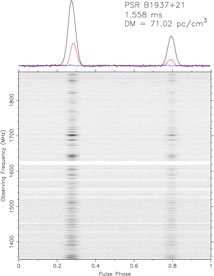
Figure: A 3.5-minute GBT L-band observation of the original millisecond pulsar B1937+21 taken with the current "default" full-Stokes, 2048-channel, 40.96-us sampling mode. The white horizontal lines show where RFI has been removed, while the dark patches are "scintles" caused by diffractive scintillation in the interstellar medium. The pulse profile at top shows the total intensity (black) as well as the linear (red) and circularly (blue) polarized components.
Beginning September 30, the new pulsar backend called GUPPI (Green Bank Ultimate Pulsar Processing Instrument) will be available for GBT pulsar observations in a shared-risk, expert user mode. GUPPI can be used for wide bandwidth (800 MHz) observations in conjunction with other existing pulsar instruments.
GUPPI's development is proceeding rapidly, with the long-term goal of having wide-bandwidth coherent de-dispersion capabilities. Its current capabilities, though, are already far superior to those available for the wide-bandwidth Spigot modes. The system available at the end of September will have the following capabilities at a minimum:
- high dynamic range provided by 8-bit sampling and output
- 2048 frequency channels across 800 MHz of bandwidth
- sampling times as fast as 20.48 ms for certain modes
- full-Stokes or only total intensity output
- software-based real-time downsampling in frequency and/or time by most powers-of-two
- on-line real-time folding of one pulsar at a time
- all output data (folded profiles or search-mode data) recorded in the new PSRFITS format
Short-term development is focusing on a 4096-channel mode and digital down-conversion that will allow narrower bandwidth modes (initially 50 MHz, 80 MHz and 200 MHz).
It is likely that observations with this instrument will be limited by the rate at which data can be processed and removed from the data-taking computer, which has 15 TB of disk space. The nominal data rate of the full-Stokes search mode with no downsampling is 200 MB/s, 8 times the Spigot data rate! Therefore, potential users are highly encouraged to only record the data that they will actually need for their science and to utilize on-line folding, the total intensity mode, and downsampling whenever possible.
For more information about using GUPPI for your project, contact Scott Ransom.
GBT K-band Focal Plane Array
F. J. Lockman
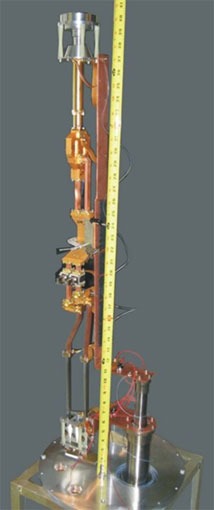
Figure: The first pixel of the GBT KFPA during test assembly in the lab. The base plate of the dewar is at the bottom with the sliding thermal waveguide joint attached to it at the left, and the refrigerator to the right. Above the waveguide are the amplifiers, isolators, noise cal source, orthomode transducer, phase shifter, and at the top, the thermal gap. All of this will be within the dewar. Above this assembly will be the dewar top, then the feed horn. The assembly is tall and slender so that all components fit within the feedhorn shadow.
The 7-pixel K-band Focal Plane Array (KFPA) project reached a milestone on August 28, 2008 when the first complete pixel was installed in the test dewar and successfully cooled to 15 deg K. This array is the first in a planned series of new multi-pixel heterodyne instruments for the GBT. It will operate in the 18-26.5 GHz frequency range with dual-polarization receivers at each pixel. The 7-pixel array is not only an important scientific instrument, but the prototype of a larger 60-pixel array for the 18-26 GHz band, and for arrays of >100 pixels at 3mm and other bands. Along with the 3 mm bolometer array MUSTANG, which begins shared-risk use this winter, the 7-pixel KFPA marks the start of an exciting new development phase in GBT capabilities.
Integration of the receiver into the dewar was the beginning of the KFPA lab test period. If all goes well, the receiver will be mounted on the GBT on September 9, and will begin sky tests shortly thereafter. The figure shows the first pixel on a lab bench before installation into the dewar. It is a complete receiver and includes all components which will be part of each subsequent pixel.
The KFPA uses some components that are newly made for this project, and their performance will be subject to special scrutiny over the next few weeks. These include the sliding waveguide expansion joints, the noise module, the thermal gap, the integrated MMIC down converter, and the Ethernet-based monitor and control communications link. The tests will check for system stability, system temperature, bandpass shape and stability, noise calibration, and the monitor and control circuitry and software. Once installed on the GBT tests will be made over the complete path back to the control room, and will include some spectra using the GBT spectrometer and continuum scans using the DCR.
The single pixel can be positioned at several locations in the focal plane, allowing us to understand aperture efficiency and beam shape differences that elements of the full array may ultimately exhibit.
After this first series of tests is analyzed a second set will be performed in October, with the goal of gathering data so that a critical design review of the entire project can be performed toward the end of this calendar year. The development plan calls for single pixel tests in 2008, full 7-pixel array tests in 2009, and release of the completed array for general observer use in late 2010.
Work is also progressing on the software pipeline for KFPA data reduction. We are in the process of defining and characterizing observing modes and developing the methodologies needed to reduce the data. At this stage it seems likely that most of the software will be reused from other projects and relatively little will be created from scratch. Notes from a data analysis meeting which was held in June and a draft memo by D.J. Pisano on spectral line observing with the KFPA, as well as photographs and progress reports are available on the project wiki: https://wikio.nrao.edu/bin/view/Kbandfpa/.
Observing with the VLA-EVLA Transition Array
Gustaaf van Moorsel
There are now 17 EVLA antennas in the array, and though the amount and severity of the teething problems we encountered initially have decreased substantially, we continue to urge all observers to carefully read the EVLA returns page prior to observing and/or data reduction.
On-going problems include:
- Aliasing in Spectral Line mode, affecting 0.5 - 0.7 MHz at the edge of the band.
- Increased, non-Gaussian noise when observing in spectral line mode at 12.5 MHz bandwidth. We strongly recommend this mode not be used.
- Issues with the first integration of some scans. We strongly recommend careful inspection and flagging, e.g., by using the AIPS task QUACK to flag approximately the first 10 seconds of every scan.
- In addition, the first 10 - 20 seconds after a change of band is often bad and not flagged. Users should make sure to observe a calibration source after a band change.
VLBA Sensitivity Upgrade
Jon Romney, Walter Brisken, and R. Craig Walker
The Digital Backend (DBE) sub-band processor module, the first element of the upgraded 4-Gbps data path, passed a major milestone with the satisfactory evaluation of the second prototype ROACH (formerly "iBOB-2") board. Limited production of copies of this board has begun for partners in the development collaboration, including the NRAO, the South African KAT project, and the UC-Berkeley CASPER Laboratory. Development of the FPGA firmware has begun, in collaboration with Haystack Observatory, which is also producing the application-layer control software. Plans for integrating this unit into the VLBA station-control system are under development. One option being explored would be based on the EVLA control system.
The only new hardware required for the Mark 5C wideband recording system, a 10-Gigabit Ethernet input interface mezzanine board, is under test by Conduant Corporation, using prototype boards and prototype FPGA code delivered recently by subcontractors. Development of the control software, as an extension of existing Mark 5A/B control software, is under way at Haystack Observatory. Integration of the recorder into the VLBA station-control system is being done in parallel with the DBE, described above.
Functional testing of the DiFX software correlator, and NRAO's implementation of it within the VLBA operational environment, is approaching completion, with the incidence of bugs becoming vanishingly small. Agreement with results from the original VLBA correlator is now excellent, both in the primary FITS UV table, and in the associated auxiliary tables as well. A substantially enhanced computation of the (u,v,w) interferometer coordinates has been incorporated, including corrections for aberration and other relativistic effects, appropriate for observations of even very near field, moving objects. More formal tests are planned for October, including functional and science-based comparisons to both the original correlator and existing correlators at other institutions. An operator's GUI, and interfaces to the VLBA Operations Management System and the NRAO archive, are under development and well advanced.
VLBA Recording Media
Jon Romney, Walter Brisken, and R. Craig Walker
It has been well over a year since we expanded the VLBA's Mark 5 recording media pool. The primary limitation has been problems in support of the newer, serial-ATA (SATA) interface rapidly being adopted by the disk-drive industry. We have deferred procurement of new SATA drives until these were resolved, and it has become difficult recently to buy drives with the older, parallel-ATA interface.
We believe this logjam has finally broken, as a result of recent tests and fixes by Conduant Corporation, in collaboration with NRAO and Haystack Observatory, in both hardware and software. We recently ordered new Mark 5 modules with a total capacity of 180 TB, which will increase the VLBA media pool to about 750 TB, 32% larger than what we have been using since mid-2007. This expanded media pool is expected to accommodate significantly more observing at both 256 and 512 Mbps.
NRAO Lab Notebook
Rick Fisher and Jim Ulvestad
A great deal of technical development work directly relevant to the Square Kilometer Array (SKA) and the future of existing radio telescopes is taking place in NRAO computing and electronics laboratories. Sometimes, this work goes unnoticed in the international arena of discussion of large future telescopes. To bring the results of the NRAO work to the attention of the astronomical community, the eNews will include a frequent "Lab Notebook" column. This column will feature non-technical descriptions of work that has been reported in journals, conferences, or internal reports with a brief description regarding how the work fits into NRAO's long-range research and development goals.
Clearly, the NRAO cannot be fully engaged in all technical development needed by SKA and other future radio instruments, so we are concentrating on our areas of expertise. These include, but are not limited to, synthesis image processing, low noise receiver systems, and digital signal processing; many of the developments are, in fact, being used or demonstrated on the EVLA. Our long-range technical goals are based on the expansion of observational parameter space, in particular, field of view, shorter millimeter wavelengths, image dynamic range, and high resolution in the time domain. All of this must be accomplished while maintaining or even improving upon the best system temperatures of current receivers.
Cost will continue to be a limiting factor in parameter-space expansion. One way we are addressing this is by simplifying receiver systems and moving the conversion to digital signals as close to the telescope feed as possible. Early digitization will also improve signal integrity, and it will allow some signal processing, such as the conversion from linear to circular polarization, to be moved from expensive waveguide components to digital arithmetic. This is only one example of areas to be featured in the "Lab Notebook" column. Specific topics to be covered in the coming year include phased array feed developments, WIDAR correlator results, ROACH board design and implementation, wide-field imaging algorithms for EVLA, PAPER antenna design, and a hybrid analog/digital sideband-separating mixer
The 2008 NRAO Summer Student Program
Toney Minter
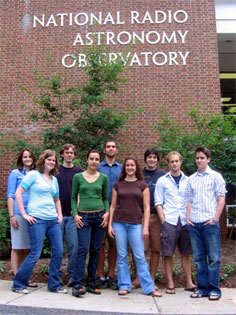
The Charlottesville Summer Students
Front Row L-R: Charli Sakari, Delia Mocanu, Evan Schneider, Daniel Lacasse
Back Row L-R: Jessica Coakley, Bryan Murphy, Tim Pennucci, Matt Schenker, Brian Sacash
Not in picture: Claudia Cyganowski, Allison Hammond, Anthony Hamzeh
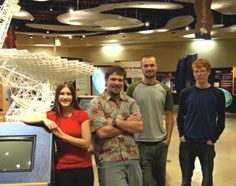
The Green Bank Summer Students
L-R: Stephanie Moats, Anthony Woody, Marc Eimers, Colin Slater
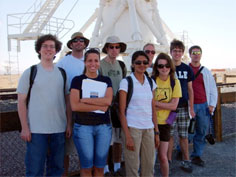
The Socorro Summer Students
Back Row L-R: Fred Davies, Josh Marvil, Ben Breslauer, Crystal Anderson, Alex Savello and Bobby Edmonds
Front Row L-R: Sarah Streb (Research Experiences for Teachers participant), Kiruthika Devaraj and Stephanie Capen
August brought to a close the 49th year of the NRAO Summer Student program. Twenty-three students participated in 2008 NRAO Summer Student program, including 16 undergraduate students supported by the National Science Foundation's (NSF) Research Experiences for Undergraduates (REU) program, three graduating seniors supported by the NRAO Undergraduate Summer Student program , and four graduate students supported by the NRAO Graduate Summer Student program. The NRAO Summer Research Program has graduated more than one thousand students in its tenure.
Summaries of the 23 students projects are available online. The summer program at each site (Green Bank, Charlottesville and Socorro) included a series of introductory level lectures on a wide variety of astronomical topics, often with an emphasis on radio astronomy and radio instrumentation.
The CV Summer Students joined the GB Summer Students on a series of four research projects using the Green Bank Telescope. Each project required the development and execution of an observing plan. With this popular aspect of their Summer experience, the 2008 students learned how to develop, execute, and interpret an observational radio astronomy project. The projects included performing OH observations of several comets, a study of radio recombination lines towards HII regions, a survey searching for extra-galactic HI and a study of formaldehyde in infrared dark clouds. The cometary OH observations will result in a published paper with Amy Lovell of Agnes Scott College. The Green Bank students were also invited to present a lecture on their summer research to the West Virginia Governor’s School for Math and Science.
The Socorro Summer Students performed two observing projects. The first of these used the VLA to search for radio emission from exoplanets. If such emission were detected, this would open a new area of physical exploration for these objects. The second summer student project used the VLBA to study the young star system V773 Tau, a quadruple system in which two stars show variable non-thermal emission. The flux density of these two stars is shown to increase when the stars are closest together, implying an interaction of their magnetospheres, though the stars have never been observed at a resolution that shows if there are structural changes to accompany the rise in flux density. The students decided to observe this system at a high resolution (a few stellar radii) to resolve the structure of these stars. The Socorro Summer Students also participated in the Eleventh Synthesis Imaging Workshop.
Applications for the 2009 NRAO summer student program will be accepted beginning later this fall. Please visit our website for more information about the NRAO summer student program.
Governor is Inspired by Governor's School Students
Sue Ann Heatherly
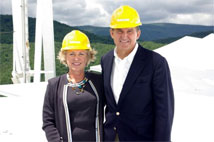
Figure 1. West Virginia Governor Joe Manchin III and First Lady Gayle Manchin atop the Green Bank Telescope.
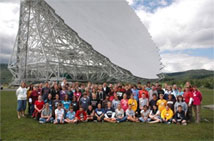
Figure 2. The students and teachers of the 2008 West Virginia Governor’s School for Math and Science at the Green Bank Telescope.
Mid-August marked the passage of the 4th annual West Virginia Governor’s School for Math and Science (GSMS) in Green Bank—a two-week residential program for 60 talented 14-year olds from around the state. In a nutshell, GSMS focuses on instilling a strong appreciation for mathematics and the sciences while students are in middle school, before they make critical decisions that will guide their academic and professional careers.
The central theme for the program is radio astronomy research. While in residence, students work as if they were professional radio astronomers. Conducting research in small teams, they observe with our 40-foot diameter radio telescope and receive a small amount of observing time on the Green Bank Telescope. They collect and analyze their data, then present their findings to each other, GSMS staff, and NRAO scientists in a colloquium. But the fun doesn’t stop there. Students also participate in directed studies including electronics, astronomical image processing, and stream ecology, in seminars that range from ball-room dancing to calculus, and in outdoor activities including caving, adventure hikes, and mountain biking.
This academic camp continues to be one of my favorite programs at the Observatory because we, the NRAO staff, get something back from the students. They are, for the most part, a joy to work with. And we’re not alone in feeling a sense of inspiration. West Virginia’s Governor, Joe Manchin III, agrees with us. He and First Lady Gayle were similarly inspired during their visit with this summer’s students on August 11.
They flew in to the site by helicopter, and took a VIP tour of the GBT before meeting the students. They were both mightily impressed by the telescope, but I think the GSMS students trumped the GBT. Governor Manchin’s words are more eloquent than mine, so I excerpt from his weekly column dated August 15, 2008. (http://www.wvgov.org/secprint.aspx?id=43&columnid=394):
“While in beautiful Pocahontas County, I caught up with the nearly 60 students who were taking part in the program. I learned as much from them about our future as I hope they learned from me about our plans to create opportunities for them right here in the Mountain State. I was impressed by their eagerness to grasp new science and research concepts, which is essential if we expect our state to compete in the global economy… As leaders responsible for our children’s growth, we must do a better job of encouraging those students who have interest or special skills in math and science to build upon those skills. Placing them in a fantastic research setting… and giving them an opportunity to learn from great scientists and professors does just that. It builds on their enthusiasm and encourages these bright young people to excel. I also saw the same enthusiasm in their mentors. The scientists and instructors, along with me, sensed the energy of these kids, and we enjoyed the opportunity to see them blossom in such a fantastic setting.”
Thank you to all of the NRAO-Green Bank staff, who not only make Governor’s School happen each year, but who also inspire and are inspired by our Governor’s School students!
West Virginia Pulsar Search Collaboratory Underway
Rachel Rosen and Maura McLaughlin (West Virginia University)
The Pulsar Search Collaboratory (PSC), a joint program between NRAO and West Virginia University, held its summer workshop this July. Green Bank hosted 15 teachers and 35 students from West Virginia, Virginia, Pennsylvania, and Texas. The workshop taught science teachers of all disciplines astronomy to use in their classrooms and engaged high school students in astronomy by teaching them to search for pulsars.
In 2007, Sue Ann Heatherly (NRAO) proposed a program to help West Virginia high school students search for new pulsars. She, along with Maura McLaughlin (WVU), Duncan Lorimer (WVU), and Scott Ransom (NRAO), applied for and received 200 hours on the GBT during the summer shutdown for the Pulsar Search Collaboratory project. Around the same time, Sue Ann, along with Co-PIs Maura and Duncan, were awarded an NSF ITEST grant to fund the Pulsar Search Collaboratory (PSC) project. This grant provided for the hire of a project manager, and in May, Rachel Rosen, a recent PhD recipient from the University of North Carolina at Chapel Hill, joined the team. Rachel will spend 50% of her time over the next three years managing the PSC project and 50% doing pulsar-related research. In addition, Don McLaughlin, a research associate in the computer science department at WVU, and his master's student, Terry Yun, joined the project to help process the data, organize the results, and develop an interface for the students. Don's cluster at WVU is processing some of the data using software designed by Scott, and Terry developed an extensive graphical database to help students access the processed data and quantitatively analyze it. Taylor Johnson at NRAO has been instrumental in creating the look and feel of the PSC database website (http://psrsearch.wvu.edu).
The first two weeks of the workshop were solely for the teachers. At their respective schools, the teachers taught a wide range of subjects, including biology, physical science, chemistry, physics, and astronomy. As astronomy was new to many teachers, they had an intensive astronomy mini-course, led by Maura and Duncan. The mini-course laid out the fundamentals of radio astronomy with a focus on pulsars. In addition, the teachers participated in various activities, including exercises in inquiry-based instruction, techniques in observational radio astronomy, and analysis of pulsar data. The teachers also received 12 hours of GBT time and Vlad Kondratiev, a postdoctoral researcher at WVU, assisted them in follow-up observations of new pulsars.
The students joined the teachers for the third week of the workshop. Since the teachers will integrate the astronomy concepts they learned in the mini-course into their classrooms during the academic year, the students received only a basic introduction into astronomy. The teachers led most of the workshop this week, including activities on the electromagnetic spectrum, quiet skies, and the use of collaboratory software for communication. Ryan Lynch, a graduate student at the University of Virginia, taught the students (and the teachers the previous week) how to interpret pulsar plots and to distinguish potential pulsars from RFI. The students were trained to use the pulsar database and to quantitatively evaluate pulsar data. Vlad taught the students the basics of observing with the GBT, and then they had the opportunity to use the GBT to observe pulsars and acquired more 350 MHz drift data. By the end of the week, the students were proficient at distinguishing pulsars from radio frequency interference and noise, and presented posters and talks on their work.
As the school year is starting, we are helping the teachers incorporate everything they learned at the workshop into their classroom while simultaneously meeting the science education standards set forth by the state of West Virginia. The teacher-led activities are designed to engage their students about pulsars and encourage them to join the PSC. By mid-October, we hope the PSC will be fully operational, with teams at each school actively searching for pulsars. The culmination of the PSC for this year will be a workshop at WVU for the high school students where they will have an opportunity to present their results. The feedback from the teachers and students from this summer has been extremely positive and we are looking forward to working with the students throughout the year!
 Zoom
Zoom